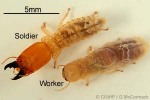Cook Islands Biodiversity Database
Species Page
Neotermes rainbowi
Coconut Termite
Multimedia & Additional Resources
| Type | Description | Download |
| Soldier and worker | 60KB | |
| Queen | 85KB | |
| Queens in opened nest | 60KB | |
| Damage on Coconut Palms | 118KB |
General Information
Cook Islands Distribution
| Southern Group: - Makatea: - | ||||||||
RR |
MG |
AT |
MK |
MT |
AK |
PL |
TK |
MN |
- |
- |
- |
- |
- |
- |
- |
- |
- |
| Northern Group: Present | |||||
TN |
MH |
RK |
PK |
NS |
SW |
- |
- |
- |
++ |
P |
++ |
Pests & Hosts
| Relationship | Pests |
| Biocontrol - internal | Heterorhabditis species, |
Scientific Taxonomy
Neotermes rainbowi (Hill, 1926)
TAXONOMY: ANIMALIA; ARTHROPODA; ATELOCERATA; HEXAPODA; INSECTA; PTERYGOTA; Isoptera; KALOTERMITIDAE
More Information
SIGNIFICANCE NOTES -
NEGATIVE SIGNIFICANCE: Serious agricultural pest (Suwarrow, Pukapuka, Nassau). Comments: First damage reported on Suwarrow in 1904, and on Pukapuka in 1945. In June 1988 Dr. M. Lenz, of the CSIRO, surveyed Suwarrow, Pukapuka and Nassau. He found them common on Suwarrow and Pukapuka, and in one small area of Nassau. On Pukapuka and Nassau residents were destroying infected palms. Lenz injected twenty infected palms on Pukapuka with a parasitic nematode Heterorhabditis sp. known to injure other species of termites in Darwin (Australia) and in Sri Lanka. The results were expected about four months later. [Lenz 1988]
GENERAL NOTE: The colony consists of the founding primary reproductives (the queen and king), the sterile soldiers and workers, and the nymphs/larvae. Typically there is only a single queen and king, but in large colonies there might be one or two secondary reproductives. If the queen or king are injured workers and nymphs can quickly mature to replace them as secondary reproductives. At certain times of the year or if there is a food-shortage many nymphs mature with wings to leave the colony as primary reproductives. If they can enter another palm through an injury in the bark, usually just above the roots, they lose their wings and start a new colony as the queen and king. As the colony develops the outer bark becomes networked with grooves covered with 'sawdust' and faecal material. Later the covering weathers away to leave an open groove. In the meantime the core of the trunk is being eaten. The primary reproductives and the larvae remain in the base, even though tunneling can extend several metres up the trunk. The weakening of the trunk often leads to it breaking during storms. [after Lenz 1988]
Vouchers & References
Vouchers:
Pukapuka: specimen+photo, 2/2004, G.McCormack with ID as Neotermes rainbowi, to BPBM.
References:
Special Reference: PM79
Data Update History (information):
zTX, zB02, zM02, zupM03b
Web Resources
Citation Information
McCormack, Gerald (2007) Cook Islands Biodiversity Database, Version 2007.2. Cook Islands Natural Heritage Trust, Rarotonga. Online at http://cookislands.bishopmuseum.org. ![]()
Please refer to our use policy.

